
Salty Sam’s Fun Blog for Children
Number 137
Wildlife Corridors
Hello Everyone

ln recent years, a lot of wildlife reservations have been especially created to give wildlife a home as the expansion of farmland has taken away more and more original natural habitats.
(Since 1930, 97% of native wild flower meadows in England and Wales have disappeared!)
But it was observed that these havens for wildlife often became isolated islands and the wildlife that lived there could not travel to the next reservation because there was not enough food to find on the journey there. This was not a good situation for them if they wanted to find a mate for example. An insect cannot pack a picnic basket like we can! ![]()
Wildlife that live in places like this are called ‘satellite populations’.
So lots of people are now planting up a strip or small corner of their gardens with plants that will support wildlife. These patches can create a home or a sort of ‘service station’ for travelling wildlife. When these patches are linked – or at least are quite close to each other, they form part of what we call ‘wildlife corridors’.
These wildlife corridors help plants and animals and insects.
A lot of our bumble bee species are in serious danger and have become very rare – in fact two have already disappeared. They need our help.
ln Britain, there are 1 million acres of garden – phew, that is a lot of space to grow beautiful plants in! lf just some of these plants fed bees, it would help them enormously.
Plant nurseries and seed merchants are usually very good about putting labels (with pictures of bees on them) on plants and seed packets to show us what bees like, so you can know which ones they are. But quite honestly, if you go to a nursery on a warm summer’s day and see all the plants lined up in their pots, the bees are already pointing out to you the plants that they like – because they will be feeding from them while they are still in the shop! ![]()
lf you want to plant a whole wild flower meadow, the first thing to do is spread yellow rattle seed. Yellow rattle weakens the grass.
This then gives the other wild flowers a chance to compete with the grass. The flower plants can be added by planting seedlings that are in plugs. The roots will already be developed and the plants will have a good chance of success.
You can grow your own plugs from seeds.
And l will tell you how important bees are to us, besides being cute and cuddly looking (don’t try and cuddle one though!) and creating a beautiful buzzing ‘summer’ sound – about 84% of Europe’s crops need bees to pollinate them!
lf you don’t have a garden but only a small back yard, did you know that you can buy turf rolls that contain wild flower plants? This turf is grown on special mats made out of recycled materials. They can be used to create ‘green roofs’ on the tops of sheds, but they can also be used on office blocks in heavily-populated cities.
Some communities create quite large gardens on roof tops. Roof top gardens were popular on large store roof tops in London at the beginning of last century and are becoming fashionable again in all sorts of different places. (You can see a roof garden on Google Maps in Kensington High Street in London and also on Cannon Street Station in the City of London.)
There are two rules to remember when making a roof garden. Make sure that the roof can take the weight of what you want to put on it and choose plants that can withstand a lot of wind. Choosing the kind of plants that do well at the seaside is a good idea because they will be able to withstand the wind you get on roofs.
People in cities don’t always have their own gardens, and this can be a way to get one. Gardens are very good for people as well as insects.
Miss Pringle is very keen to teach the children in her class at the Rocky Bay Primary School which flowers are good for feeding bees but she said if you can’t remember their names, you can remember that flat ones are usually better than frilly ones!
The bees are in serious trouble and are relying on kind-hearted children and adults everywhere to help them.
Have you helped with any projects like this?
Bye bye everyone – don’t forget to subscribe to my blog!
lf you like my blog, please support it by telling all your friends and followers about it.
Thank you!
And see you again next Fun Friday!
Love and kisses
Salty Sam

www.christina-sinclair.com

Bill and Bob’s Joke of the Week![]()
![]()
Bill: Why did the insect football team drop the centipede from their squad?
Bob: l don’t know. Why did the insects drop the centipede from their football team?
Bill: Because he was taking too long to put his boots on!
Bob: Oh – shame.

Salty Sam © Christina Sinclair 2015
Unauthorized use and/or duplication of material from this blog without express and written permission from this blog’s author and owner is strictly prohibited.
Links may be used to www.christina-sinclair.com

Picture Gallery

Primroses growing by the roadside in a grass verge in the spring

Celandines growing at the bottom of a hedge in the spring

Bees love green alkanet

Cow parsley is a common roadside flower
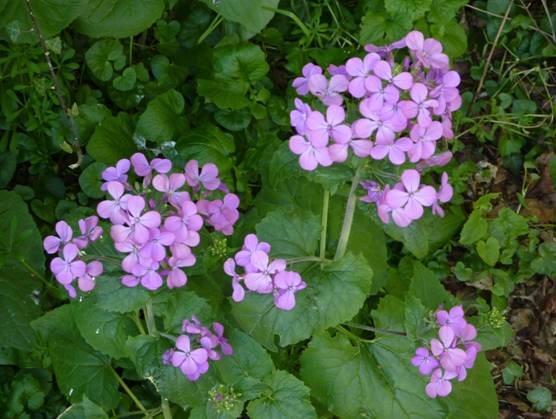
This flower is called Dame’s Rocket

Garlic mustard growing along the bottom of a fence by the road

A narrow strip of poor soil at the base of a wall is a perfect place for a collection of wild flowers

Buddleia is also known as the butterfly bush and is often seen growing along railway banks and on waste ground

Bees love clover left in a lawn

An uncut roadside verge with buttercups, daisies, clover and dandelions
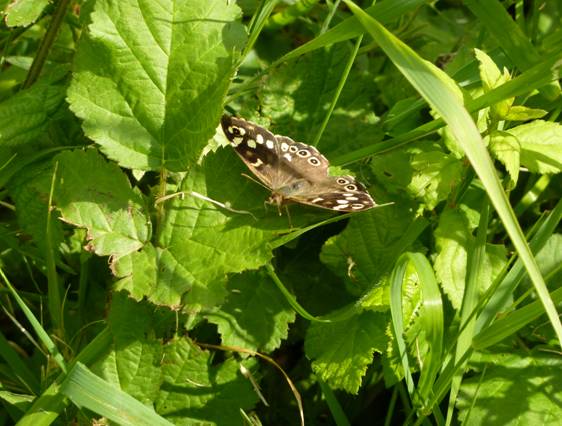
Speckled wood butterfly

A Small Tortoiseshell butterfly on a roadside verge in summer

This is a Peacock butterfly
It is found throughout Europe, the warmer countries of Asia and as far east as Japan

A wildflower insect service station by the road

Green roofs can be laid in the cities or the countryside

Derry and Tom’s Roof Garden actually had flamingos in it

A wild flower garden on a roof in London near Southwark Cathedral

Green walls as well as a green roof in the City of London

Don’t try and grow trees on your roof – they are too heavy and they need deep soil for their roots!
(Some people successfully put trees on their roofs but it is rare)

Look out for this sign when you buy plants

A hollyhock seed thrown at the roadside develops into a flower which will be found by bees

 THE SALTY SAM NEWS DESK
THE SALTY SAM NEWS DESK

Bill, Bob, Henry and Emily noticed last summer that when their school caretaker, Mr Grumps, mowed their school field, he was mowing right up to the edge.
They asked Miss Pringle their teacher if she could ask him whether he thought it was a good idea to leave a strip about 2 meters wide all the way around the edge of the field in future so that the wild flowers growing in the grass could be left for the bees.
Luckily, he thought that it was a wonderful idea. If nothing else, it gave him slightly less work to do!
![]()

Now the grass at the edge of the field is going to be left for the bees, and there will still be loads of room for the children to play.
Just imagine if all schools did this – how many more acres there would be in the whole country containing flowers to feed the bees!
![]()
In addition, the school has planted some plants at the playing field boundaries that will produce flowers and berries to feed other wildlife.

Roses in a hedgerow in the summer

Rosehips in the autumn

Hawthorn berries at the end of the summer
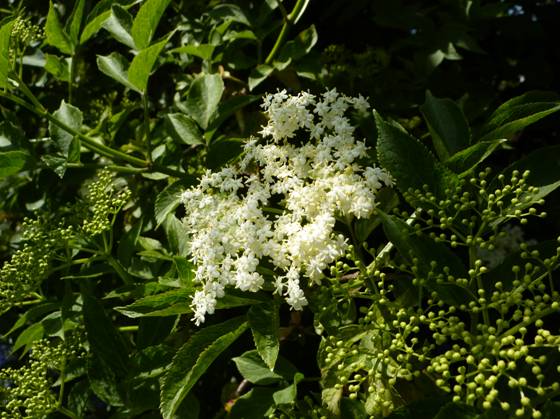
Elders have flowers and berries

Bees love ceanothus flowers –
when ceanothus grow very tall they look like blue trees!
If you would like to make a wildlife corridor, you could start collecting seeds now and plan what you would like to do this winter. Then you will be ready to start planting one next spring.

*********************
TO ADVERTISE ON THIS BLOG
PLEASE CONTACT:
christina.sinclair.ads@aol.co.uk
*********************


Hobby Time
This is a really neat idea for making seed bombs so that you can become a city gardener – let me explain what that is.
Wildlife doesn’t always live in the countryside. People in towns have birds, badgers, foxes and butterflies visiting their gardens, and gardens account for over a million acres in this country.
But there are other areas in town that are small areas of waste ground that can look scruffy if neglected. Communities can adopt these areas and brighten them up with flowers and even small trees.
lt could be a strip of land along side a road or a roundabout or an alleyway between buildings. Some villages even have a large pond on their village green. Ponds are very good for wildlife.
Seed bombs are a way of planting seeds in places that are hard to get to – most seeds are light and will blow away, if you throw them out of a car window or over a fence as they are – but please remember some very important things:-
- lf you throw these seed bombs out of a car window, do not lean out of the window because there might be a car coming past you
- Also, don’t lob them onto other people’s gardens – they are only for waste ground
- Don’t include tree seeds in them if you are throwing them onto railway embankments because it is not good to have trees too close to railways
- Never throw things at people or animals
- lf you collect the seed yourself, you will save a lot of money
- The seeds can be from flowers that you are growing in the garden like lupins and foxgloves, you don’t have to only use wild flowers
Put some clay powder and compost and flower seeds in a bowl in equal proportions and add water in very tiny amounts as you stir.
When the clay mixture is sticky, roll it into little balls and leave on a non-stick surface to dry. A flat carrier bag or dustbin liner will do.
Keep your seed bombs in a strong paper bag or box and keep them dry.
Then you can have fun launching them into a place that could do with some wild flowers!
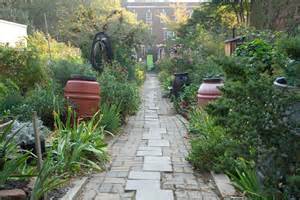
BLOW MY FOGHORN!!!

PLUS
Salty Sam fans can join in with their comments and share them with children all over the world. You will need to ask permission if you are not an adult.
Enter your e-mail address to subscribe to my blog and receive new Salty Sam Blog Posts for free by e-mail every week. Your address will be kept private and will not be shared with any third party.
Sign me up at the side bar



lt’s the Weekend!

HOW TO MAKE A DOLLS’ HOUSE GARDEN
The garden can be made any size and shape, and of course you can add your own ideas and accessories.

Firstly, you will need a lawn which is simply made with a sheet of felt, or if bought off a roll, you can have one as large as you want.
Mottled, light brown felt or grey felt can be used for pathways and stepping stones.
You can either build your garden onto a stout piece of cardboard and store it away in one piece or make it in pieces which will allow you to redesign it frequently. You will also be able to store it in a box when you are not playing with it.
The vegetable patch and flower beds can be made any size too.
The trellis fence is made from two strips of plastic canvas. The fence in the photograph is 90 holes by 20 holes and the base is 90 holes by 11 holes.
Create the stems of the climbers in straight stitches in cream, brown or green yarn – try to keep the threads at the back of the fence behind the ones at the front. The foliage is created by sewing very loose French knots wound around a yarn needle five times and the roses are tighter French knots made by winding the yarn around the needle three times. Put your needle back through a different hole from the one you came out of to ensure that the knots stay on the front of the fence. Then work a line of grass along the bottom of the fence adding a few flowers in French knots pulled up into a point.

Cover the base in brown yarn worked in diagonal stitches and attach to the back fence using over-sew stitch – as long as the flower bed is wide enough the fence should stand up on its own but keep the underneath of the base very flat. If you want to put flowers in this bed, make a flower border separately to sit on the top.
Make conifers and potted flowers by taking different shades of green threaded into a yarn needle and sew it into itself over and over. Make a few knots in the yarn at the beginning to get you started. Start at the bottom of the tree and work up. Keep the work in a round shape and add coloured flowers to make a flower container. Then rest the conifers or flowers on an upturned bottle top.

To make a hutch/chicken coop/kennel; take a small box, use sticky tape to stick together a roof – you will need triangles at each end. Paint won’t stick to sticky tape so you will have to put a surface on top to paint. Cover with papier machė or glue on corrugated cardboard or match sticks. You can make a stand out of plastic canvas sewing some foliage or grass around the bottom of it in green yarn.
To make the vegetable patch use brown dk knitting yarn and knit in a 4 row pattern (k1 row, purl 1 row, purl 1 row, knit 1 row). Run French knots of green along the plot to create sprouting crops. (You will need to cast on about 18 stitches for every 10 cm of width that you want – this bed is 15cm wide and the length of the knitting is 7½cm.)
Run French knots worked in green yarn along a piece of dark brown felt and put under a plastic box from packaging from a mascara tube or batteries to make a cloche. You can make larger cloches from the plastic packaging of batteries or pancake rolls that are sold in the supermarket.
To make the hedge take lengths of rainbow-green, textured yarn and knit it into strips using garter stitch. Then sew each strip into a thin tube and stuff it unevenly with lumps of toy stuffing. The more uneven the finished effect; the more it will look like a hedge. Work some French knots very loosely along the top if you want extra texture on the top. This hedge is 12 stitches wide – you can increase and decrease as you go along to vary the width if you like.
To make the rockery or flower bed; use various shades of green yarn and work loose French knots into a base of dark brown or black felt. You can incorporate a pond by covering a piece of card on silver foil and placing the card under a hole cut in the felt. The pond can be square or rectangular in a formal garden or round or a kidney shape in a less formal one.

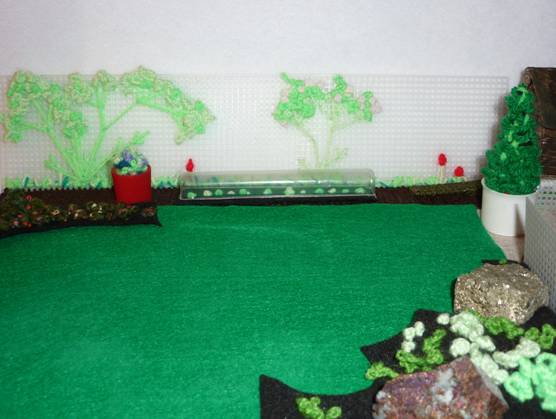





Please note that the material on this blog is for personal use and for use in classrooms only.
It is a copyright infringement and, therefore, illegal under international law to sell items made with these patterns.
Use of the toys and projects is at your own risk.
©Christina Sinclair Designs 2015
For an Embroidery Stitches Chart
Check out Blog Post 3




I have arthritis in my hands and have tried several jar openers. So, I’m looking fro a jar opener.
Well, this is a strange question to ask me, but try whacking the side of the jar lid on a door frame and the lid should just pop open. Then you will have absolutely no trouble in twisting it off so you will not need a jar opener. Or you can use the hook on a can opener to loosen the lid to let air into the jar. When you hear it pop, the jar will be easy to open.